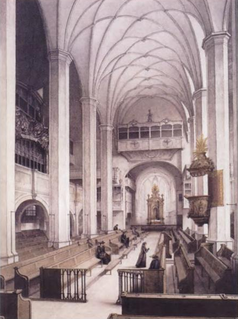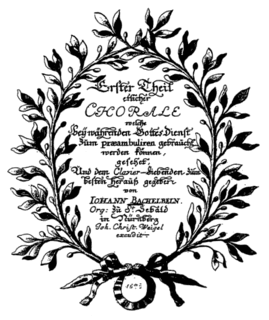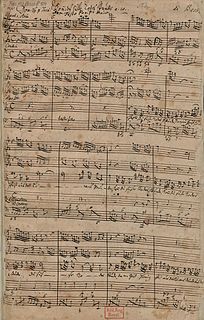Related Research Articles
Johann Pachelbel was a German composer, organist, and teacher who brought the south German organ schools to their peak. He composed a large body of sacred and secular music, and his contributions to the development of the chorale prelude and fugue have earned him a place among the most important composers of the middle Baroque era.

Liebster Gott, wenn werd ich sterben?, BWV 8, is a church cantata for the 16th Sunday after Trinity by Johann Sebastian Bach. It is a chorale cantata, part of Bach's second cantata cycle. Bach performed it for the first time on 24 September 1724 in St. Nicholas Church in Leipzig. The cantata is scored for SATB singers, four wind instruments, strings and continuo.

The Orgelbüchlein BWV 599−644 is a set of 46 chorale preludes for organ — one of them is given in two versions — by Johann Sebastian Bach. All but three were written between 1708 and 1717 when Bach served as organist to the ducal court in Weimar; the remainder and a short two-bar fragment came no earlier than 1726, after the composer’s appointment as cantor at the Thomasschule in Leipzig.
The year 1683 in music involved some significant events.

Johann Sebastian Bach composed the church cantata Es ist nichts Gesundes an meinem Leibe, BWV 25 in Leipzig for the 14th Sunday after Trinity and first performed it on 29 August 1723.
Johann Peter Kellner was a German organist and composer. He was the father of Johann Christoph Kellner.
Johann Krieger was a German composer and organist, younger brother of Johann Philipp Krieger. Born in Nuremberg, he worked at Bayreuth, Zeitz, and Greiz before settling in Zittau. He was one of the most important keyboard composers of his day, highly esteemed by, among others, George Frideric Handel. A prolific composer of church and secular music, he published several dozen of his works, and others survive in manuscript. However, hundreds more were lost when Zittau was destroyed by fire in 1757, during the Seven Years' War.

Erster Theil etlicher Choräle is a collection of liturgical organ music by Johann Pachelbel, published during his lifetime. It contains eight chorale preludes in seven different styles.
Eleven Chorale Preludes, Op. 122, is a collection of works for organ by Johannes Brahms, written in 1896 at the end of the composer's life and published posthumously in 1902. They are based on verses of nine Lutheran chorales, two of them set twice, and are relatively short:
- Mein Jesu, der du mich in e
- Herzliebster Jesu, was hast du verbrochen in g
- O Welt, ich muß dich lassen in F
- Herzlich tut mich erfreuen in D
- Schmücke dich, o liebe Seele in E
- O wie selig seid ihr doch, ihr Frommen in d
- O Gott, du frommer Gott in a
- Es ist ein Ros’ entsprungen in F
- Herzlich tut mich verlangen in a
- Herzlich tut mich verlangen in a
- O Welt, ich muß dich lassen in F

Johann Sebastian Bach composed the church cantata Komm, du süße Todesstunde, BWV 161, in Weimar for the 16th Sunday after Trinity, probably first performed on 27 September 1716.

Nimm, was dein ist, und gehe hin, BWV 144, is a church cantata by Johann Sebastian Bach. He composed it in Leipzig for the Sunday Septuagesimae, the third Sunday before Lent, and first performed it on 6 February 1724.

Johann Sebastian Bach composed the church cantata Was Gott tut, das ist wohlgetan, BWV 99, in Leipzig for the 15th Sunday after Trinity and first performed it on 17 September 1724. The chorale cantata is based on the hymn "Was Gott tut, das ist wohlgetan" by Samuel Rodigast (1674).

Johann Sebastian Bach composed the church cantata Was Gott tut, das ist wohlgetan, BWV 98, in Leipzig for the 21st Sunday after Trinity and first performed it on 10 November 1726.

Liebster Immanuel, Herzog der Frommen, BWV 123, is a church cantata by Johann Sebastian Bach. He composed the chorale cantata in Leipzig for Epiphany and first performed it on 6 January 1725. It is based on the hymn by Ahasverus Fritsch (1679).
There are 52 chorale cantatas by Johann Sebastian Bach surviving in at least one complete version. Around 40 of these were composed during his second year as Thomaskantor in Leipzig, which started after Trinity Sunday 4 June 1724, and form the backbone of his chorale cantata cycle. The eldest known cantata by Bach, an early version of Christ lag in Todes Banden, BWV 4, presumably written in 1707, was a chorale cantata. The last chorale cantata he wrote in his second year in Leipzig was Wie schön leuchtet der Morgenstern, BWV 1, first performed on Palm Sunday, 25 March 1725. In the ten years after that he wrote at least a dozen further chorale cantatas and other cantatas that were added to his chorale cantata cycle.

Was Gott tut, das ist wohlgetan, BWV 100, is a church cantata by Johann Sebastian Bach. He composed it in Leipzig between 1732 and 1735. The chorale cantata is based on the hymn "Was Gott tut, das ist wohlgetan" Samuel Rodigast (1674).
"Herzlich tut mich verlangen" is a German hymn, with lyrics written in 1611 by Christoph Knoll, with a melody adapted from a secular song by Hans Leo Hassler. It is a prayer for a blessed death, beginning "Herzlich tut mich verlangen nach einem sel'gen End". Its hymn tune, Zahn No. 5385a, was later also used for Paul Gerhardt's "Befiehl du deine Wege" and "O Haupt voll Blut und Wunden".

"Was Gott tut, das ist wohlgetan" is a Lutheran hymn written by the pietist German poet and schoolmaster Samuel Rodigast in 1675. The melody has been attributed to the cantor Severus Gastorius. An earlier hymn with the same title was written in the first half of the seventeenth century by the theologian Michael Altenburg.

52 chorale preludes, Op. 67, is a collection of 52 settings of popular Protestant hymns for organ by Max Reger, composed between 1900 and 1902. Originally published in three volumes between 1900 and 1903 with the cover title "52 Choralvorspiele für Orgel", the full title of the collection was "Zweiundfünfzig leicht ausführbare Vorspiele zu den gebräuchlichsten evangelischen Chorälen".
"Befiehl du deine Wege" is a Lutheran hymn by Paul Gerhardt. It is one of his best known hymns, and was first published in 1653 in Johann Crüger's collection of hymns and popular religious songs Praxis pietatis melica.
References
- Cesare Fertonani. "Johann Pachelbel. Musikalische Sterbens-Gedanken." Liner notes for CD Edoardo Belotti, Maurizio Salerno. Johann Pachelbel: Musikalische Sterbens-Gedanken., Amadeus AM 197-2
- Ewald V. Nolte, John Butt. "Johann Pachelbel", Grove Music Online , ed. L. Macy (accessed 29 December 2005), grovemusic.com (subscription access).